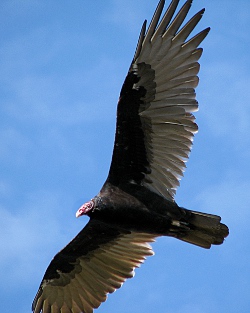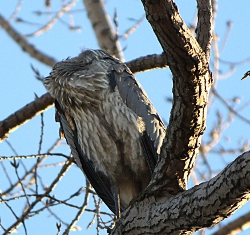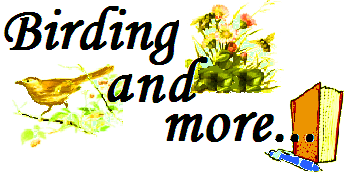 Newsletter
Newsletter
2010
/ Issue 14
IN THIS ISSUE: THE BIG BIRDS OF BELLEVILLE
Two of the largest birds in this area are the Great Blue Heron and the Turkey Vulture. With wing spans of 70 and 72 inches respectively these massive birds are only out-reached by swans and eagles.
The Great Blue Heron is one of my all time favourite birds! These amazing creatures are both graceful and powerful.
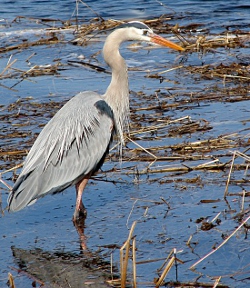 They
survive by having incredible hunting skills and the ability to swallow
huge fish, frogs, and other prey whole - although they have been known
to choke to death when their eyes are bigger than their gullets.
They
survive by having incredible hunting skills and the ability to swallow
huge fish, frogs, and other prey whole - although they have been known
to choke to death when their eyes are bigger than their gullets.In Belleville we are fortunate enough to have a lot of waterways, and these beautiful great birds can be seen in many places: the wetlands of the H.R.Frink Centre, along the Moira River, along the shoreline of the bay, at the Quinte Conservation Area, and in numerous places in Prince Edward County. The Great Blue Herons are migratory, but they sometimes stay late into the winter season before heading south. They are often
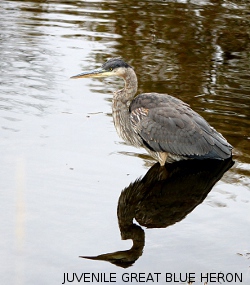 easy to approach, so if you spot one you should be able to get a good
look. They are well known for their stealth abilities when catching
fish, but did you know that mice make up a large part of the Heron's
diet?
easy to approach, so if you spot one you should be able to get a good
look. They are well known for their stealth abilities when catching
fish, but did you know that mice make up a large part of the Heron's
diet?
Great Blue Heron facts
Adult length 38"
Wingspan 70"
Flight speed: 40 km/h
Clutch size: 3-5 eggs
Incubation period: 27 days
Nestling period: 55-65 days
Juvenile mortality: 75%
Life expectancy: 10 - 18 years
The Turkey Vulture is another very large bird that makes its
home in the Belleville area. These majestic birds of
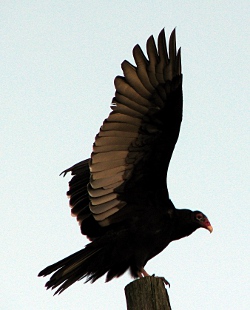
Turkey Vultures are gregarious birds that often roost in large numbers.
I am always happy to see these giant birds floating overhead on a sunny
day.
Turkey Vulture facts
Adult length 32"
Wingspan 72"
Clutch size: 1-3 eggs
Incubation period: 38 days
Nestling period: 70-80 days
Life expectancy: 16 years
. If you have any questions, don't hesitate to drop me a line at
garry@birdingandmore.com
THE READERS' PATCH
In this issue we feature the photographs of Barry Kant.
.jpg)
Northern Saw-whet Owl
In contrast to this
newsletter's theme of bigger birds, here are a couple of photos taken by
Barry Kant of the smallest owl in the Belleville area.
Barry sent several photos of this great owl, taken at Prince Edward
Point. This next picture is my favourite.
.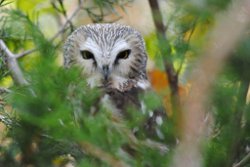
Northern Saw-whet Owl
The Readers
Patch is
a space for your photos, stories, and/or comments.
Send anything
you'd like to share with us to: newsletter@birdingandmore.com
|
QUIZ -
Here's a picture I took the other day of a 'headless' bird
perched high in a tree near the Bay of Quinte. Can you guess
what it is?
The answer is
waiting at the bottom |
WOW - there's been a lot going on at Birding and more!
The Blog is now a Daily Bird Report, providing local sightings, photos, and information about what's going on bird-wise.
More photos have
been added to the galleries, and now we are offering those photos as
framed 8x10 prints for $49 - just in time for Christmas!
![]()
A catalogue of suggested photos and sample frames will be on the website
soon!
We are also really excited to be adding wildlife videos shot by Garry &
Elaine - also coming to the website very soon!
We're well into Fall now and the garden is going to sleep. This weekend (which happens to be Thanksgiving) is lovely and mild but the days are still getting shorter and the nights cooler. The shrubs are losing their leaves and the perennials are mostly bare stems poking up from the ground. I feel a little sad to see the luxuriant growth and vibrant colours coming to an end but it's wonderful to know that it will begin again in a few months. And as I hinted in my last Elaine's Corner, I can have fun working on my list of new fall-flowering plants for next spring that will add a splash of colour at the end of summer – I'm not done yet!
At the moment we're trying to find ways to cut down on the cost of stocking our bird feeders and we've decided to simply cut back a bit. There really weren't a lot of birds using the feeders this past summer – a
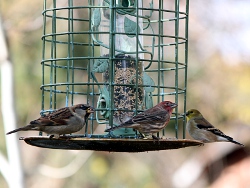 nice bit of activity but not as much as previous years – and there
were definitely very few birds last winter and it sounds like this year
won't be much better. So... we've removed a couple of our safflower
feeders leaving just two (the two that seemed to be most popular), and
while we have three finch feeders at the moment (there has been a sudden
influx of goldfinches
nice bit of activity but not as much as previous years – and there
were definitely very few birds last winter and it sounds like this year
won't be much better. So... we've removed a couple of our safflower
feeders leaving just two (the two that seemed to be most popular), and
while we have three finch feeders at the moment (there has been a sudden
influx of goldfinches
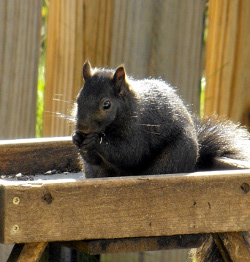 the blue jays. We'll also add our peanut
butter “plug” feeder and a couple of suet feeders as it gets colder, and
we'll continue to put out sunflowers for the squirrels on their small
tray feeder. And of course there's the millet! It doesn't sound like
there's going to be a huge reduction after all (which is good, because
we do love feeling like we're providing for the wildlife that comes to
our garden) but hopefully we've kept the less expensive feed and our
budget won't suffer for our hobby. I suppose the main thing we've given
up is the great amount of peanuts in the shell that we put out for the
squirrels, and the “squirrel-free” mixed seed we bought for one feeder –
the two most expensive components of our shopping list. Now we just have
to sit back, enjoy the transition, and see who's coming for dinner!
the blue jays. We'll also add our peanut
butter “plug” feeder and a couple of suet feeders as it gets colder, and
we'll continue to put out sunflowers for the squirrels on their small
tray feeder. And of course there's the millet! It doesn't sound like
there's going to be a huge reduction after all (which is good, because
we do love feeling like we're providing for the wildlife that comes to
our garden) but hopefully we've kept the less expensive feed and our
budget won't suffer for our hobby. I suppose the main thing we've given
up is the great amount of peanuts in the shell that we put out for the
squirrels, and the “squirrel-free” mixed seed we bought for one feeder –
the two most expensive components of our shopping list. Now we just have
to sit back, enjoy the transition, and see who's coming for dinner!Answer to the quiz:
A young Great Blue Heron that had his head
tucked under his wing! Amazing, eh?
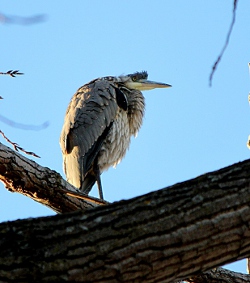
If you liked our newsletter
please pass it along to your friends and family.
Subscriptions are free! Just send an
email to: newsletter@birdingandmore.com
Copyright © 2010 Garry Kirsch www.birdingandmore.com
If you wish to cancel your subscription send an email to unsubscribe@birdingandmore.com
